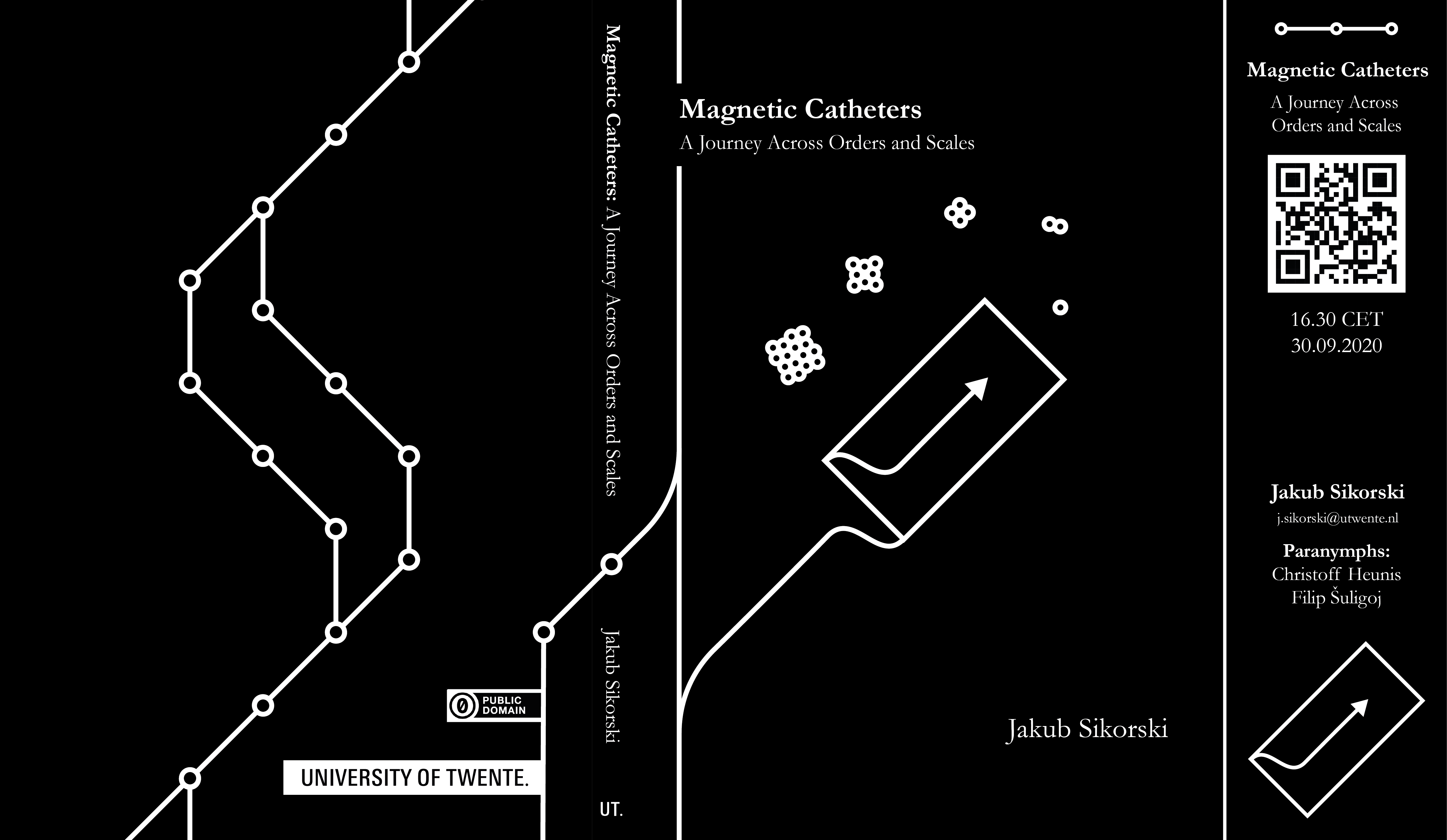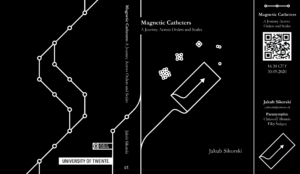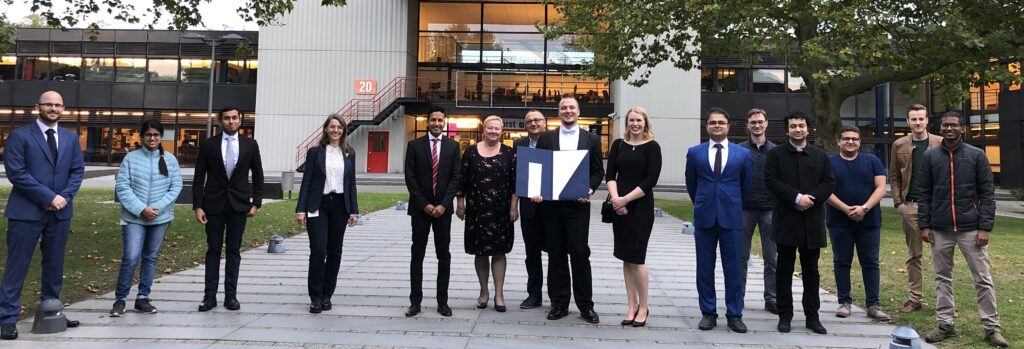
PhD Defense – Jakub Sikorski
SRL doctoral candidate defended his thesis.
 The defense of the doctoral thesis titled “Magnetic Catheters: A Journey Across Orders and Scales” by Jakub Sikorski was on Wednesday, 30th of September 2020 at 16:30 CET in the Prof. dr. G. Berkhoffzaal room, in the Waaier building at the University of Twente. Due to COVID-related audience restrictions, the defense is invite-only and is made available for the public online at: https://vimeo.com/event/107744/videos/463494738/
The defense of the doctoral thesis titled “Magnetic Catheters: A Journey Across Orders and Scales” by Jakub Sikorski was on Wednesday, 30th of September 2020 at 16:30 CET in the Prof. dr. G. Berkhoffzaal room, in the Waaier building at the University of Twente. Due to COVID-related audience restrictions, the defense is invite-only and is made available for the public online at: https://vimeo.com/event/107744/videos/463494738/
Jakub’s doctoral thesis is available here.
Thesis summary:
 Research in minimally-invasive surgery (MIS) develops means to diagnose and treat patients quickly, precisely and through minimal access ports, with the ultimate aim of making surgical procedures cheaper, less distressful and more effective than current state-of-the-art. Technological progress in engineering and life sciences empowers the MIS tool-kit, which already enables several revolutionary medical procedures, such as endoscopy, cardiac ablation, image-guided biopsies or angioplasty. When an MIS procedure requires access to a deep-seated region, various groups of flexible surgical instruments are employed to operate inside the body through narrow incisions. Related challenges can be approached with robotic solutions, whereby real-time sensing and automation improve the in situ behaviour of flexible instruments.
Research in minimally-invasive surgery (MIS) develops means to diagnose and treat patients quickly, precisely and through minimal access ports, with the ultimate aim of making surgical procedures cheaper, less distressful and more effective than current state-of-the-art. Technological progress in engineering and life sciences empowers the MIS tool-kit, which already enables several revolutionary medical procedures, such as endoscopy, cardiac ablation, image-guided biopsies or angioplasty. When an MIS procedure requires access to a deep-seated region, various groups of flexible surgical instruments are employed to operate inside the body through narrow incisions. Related challenges can be approached with robotic solutions, whereby real-time sensing and automation improve the in situ behaviour of flexible instruments.
This thesis studies a subgroup of flexible instruments called catheters. Catheters are sleek tubes navigated through the natural cavities of human body to reach remote organs with minimum tissue damage. However, due to their high mechanical compliance, catheters are challenging to steer once inside the body. This limits their applicability to a narrow range of tasks, predominantly in endovascular surgery. Dexterity of a catheter can be increased by integrating into its structure coils or permanent magnets, which experience forces/torques in external magnetic field. Such magnetic catheters are capable of exhibiting complex mechanical behaviour, while being structurally simpler than comparable devices. The following chapters demonstrate how, by using the principles of robotics, this behaviour can be harnessed to execute clinically-relevant tasks. Contributions are made in three general areas. The thesis proposes novel designs of magnetic catheters, explores the means to sense and model their behaviour and devises control strategies enabling their operation.
 Magnetic catheters bridge scales. They belong to mesoscale, as their functional part is situated at their tip, with a diameter expressed in millimetres and length of several centimetres. However, their total length can exceed a meter, and thus, from that perspective, they can be also considered macroscale. This multiscale geometry allows magnetic catheters to successfully operate inside the human body, while being actuated externally by macroscale auxiliary systems. Yet, the catheters ultimately target living tissue, which exhibits complex behaviour mediated at micro- and nano- scales. Thus, to explore the broad domain of magnetic catheters searching for clinically-relevant solutions, this thesis takes the reader on a journey through orders of magnitude.
Magnetic catheters bridge scales. They belong to mesoscale, as their functional part is situated at their tip, with a diameter expressed in millimetres and length of several centimetres. However, their total length can exceed a meter, and thus, from that perspective, they can be also considered macroscale. This multiscale geometry allows magnetic catheters to successfully operate inside the human body, while being actuated externally by macroscale auxiliary systems. Yet, the catheters ultimately target living tissue, which exhibits complex behaviour mediated at micro- and nano- scales. Thus, to explore the broad domain of magnetic catheters searching for clinically-relevant solutions, this thesis takes the reader on a journey through orders of magnitude.
After a general introduction (Chapter 1), we present a series of studies, divided into three parts, with each part focusing on challenges relevant to a particular scale. Part I describes the development of two generations of auxillary systems for magnetic actuation. These macroscale systems employ electromagnets located outside of the body of the patient to transmit power to a range of magnetic catheters. BigMa
g (Chapter 2) is an array of mobile electromagnets utilising optimization-based inverse field map to generate prescribed magnetic fields on demand. Knowledge gained during the development of BigMag is then used to inform design of the ARMM (Advanced Robotics for Magnetic Manipulation) system (Chapter 3). The ARMM system employs a single mobile electromagnet located on a robotic arm, allowing for magnetic steering in a workspace suitable for minimally-invasive surgical procedures. Both of these systems are applied in Part II, which explores mesoscale, focusing on design, modelling and control of millimetre-sized distal parts (tips) of magnetic catheters for clinically-relevant tasks of motion control (Chapter 4), grasping (Chapter 5) and ultrasound-guided projectile delivery (Chapter 6). Subsequently, Part III reconsiders the role of magnetic catheter within MIS, treating it as auxiliary infrastructure toactuate even smaller objects, thus providing means for controlled interaction with human body in microscale. MILiMAC (Microrobotic Infrastructure Loaded into Magnetically-Actuated Catheter) is a mesoscale device that can be considered both an electromagnet array and a magnetic catheter (Chapter 7). It is a proof-of-concept solution addressing the challenge of steering microrobotic agents in remote regions of human body. Ultimately, the range of topics approached by this thesis is summarised in Part IV, providing general conclusions and outlook (Chapter 8).
Promotor
- Prof. dr. S. Misra (University of Twente/University Medical Center Groningen, The Netherlands)
Thesis Committee
- Prof. Dr. Ir. H. F. J. M. Koopman (University of Twente, The Netherlands)
- Prof. Dr. P. E. Dupont (Boston Children’s Hospital, Harvard Medical School, USA)
- Prof. Dr. Ir. M. Steinbuch (Eindhoven University of Technology, The Netherlands)
- Prof. Dr. J. G. Grandjean (University of Twente, The Netherlands)
- Prof. Dr. Ing. J. Arens (University of Twente, The Netherlands)
- Dr. V. Kalpathy Venkiteswaran (University of Twente, The Netherlands)



